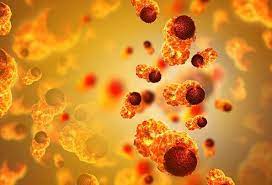Malignancy makes cells partition wildly. This can bring about cancers, harm to the resistant framework, and other hindrance that can be deadly.
In the United States, an expected 15.5 million individuals with a background marked by malignancy were living as of January 1, 2016, as per a 2018 report from the American Cancer Society.
In this article, we inspect sorts of malignant growth, how the sickness creates, and the numerous therapies that assist with working on the personal satisfaction and endurance rates.
What is cancer?
Malignant growth is an expansive term. It depicts the illness that outcomes when cell changes cause the uncontrolled development and division of cells.
A few sorts of diseases cause quick cell development, while others cause cells to develop and partition at a more slow rate.
Certain types of disease bring about noticeable developments called cancers, while others, like leukemia, don’t.
The greater part of the body’s cells has explicit capacities and fixed life expectancies. While it might seem like something terrible, cell passing is important for a characteristic and useful wonder called apoptosis.
A cell gets directions to kick the bucket so the body can supplant it with a fresher cell that capacities are better. Harmful cells do not have the parts that educate them to quit partitioning and to bite the dust.
Subsequently, they develop in the body, utilizing oxygen and supplements that would for the most part sustain different cells. Harmful cells can shape growths, impede the invulnerable framework and cause different changes that keep the body from working routinely.
Destructive cells might show up in one region, then, at that point spread by means of the lymph hubs. These are groups of safe cells situated all through the body.
Causes
There are many reasons for disease, and some are preventable.
For instance, more than 480,000 individuals pass on in the U.S. every year from smoking cigarettes, as per information announced in 2014.
As well as smoking, hazard factors for the disease include:
hefty liquor utilization
abundance body weight
actual latency
helpless sustenance
Different reasons for malignancy are not preventable. Right now, the main inevitable danger factor is age. As indicated by the American Cancer Society, specialists in the U.S. analyze 87% of malignancy cases in individuals ages 50 years or more established.
Is malignancy hereditary?
Hereditary components can add to the advancement of the disease.
An individual’s hereditary code advises their cells when to isolate and lapse. Changes in the qualities can prompt broken directions, and disease can result.
Qualities likewise impact the cells’ creation of proteins, and proteins convey a significant number of directions for cell development and division.
A few qualities change proteins that would as a rule fix harmed cells. This can prompt malignancy. On the off chance that a parent has these qualities, they might give the modified directions to their posterity.
Some hereditary changes happen after birth, and factors, for example, smoking and sun openness can expand the danger.
Different changes that can bring about disease occur in the substance flags that decide how the body conveys, or “communicates” explicit qualities.
At long last, an individual can acquire an inclination for a kind of malignancy. A specialist might allude to this as having an inherited malignancy disorder. Acquired hereditary changes altogether add to the advancement of 5–10 percent of disease cases.
Types
The most widely recognized kind of malignancy in the U.S. is bosom malignancy, trailed by lung and prostate diseases, as per the National Cancer Institute, which rejected nonmelanoma skin tumors from these discoveries.
Every year, in excess of 40,000 individuals in the nation get a conclusion of one of the accompanying sorts of malignant growth:
bladder
colon and rectal
endometrial
kidney
leukemia
liver
melanoma
non-Hodgkin’s lymphoma
pancreatic
thyroid
Different structures are more uncommon. As indicated by the National Cancer Institute, there are more than 100 kinds of malignancy.
Malignant growth improvement and cell division
Specialists characterize malignancy by:
its area in the body
the tissues that it shapes in
For instance, sarcomas create in bones or delicate tissues, while carcinomas structure in cells that cover inside or outside surfaces in the body. Basal cell carcinomas create in the skin, while adenocarcinomas can frame in the bosom.
At the point when dangerous cells spread to different pieces of the body, the clinical term for this is metastasis.
An individual can likewise have more than each kind of malignancy in turn.
Treatments
The creative examination has energized the advancement of new prescriptions and treatment advances.
Specialists normally endorse therapies dependent on the sort of disease, its stage at analysis, and the individual’s general wellbeing.
The following are instances of ways to deal with disease treatment:
Chemotherapy intends to kill destructive cells with prescriptions that target quickly separating cells. The medications can likewise assist with contracting cancers, however, the incidental effects can be extreme.
Chemical treatment includes taking prescriptions that change how certain chemicals function or meddle with the body’s capacity to deliver them. At the point when chemicals assume a huge part, likewise with prostate and bosom tumors, this is a typical methodology.
Immunotherapy utilizes prescriptions and different therapies to help the safe framework and urge it to battle harmful cells. Two instances of these medicines are designated spot inhibitors and supportive cell move.
Accuracy medication, or customized medication, is a fresher, creating approach. It includes utilizing hereditary testing to decide the best therapies for an individual’s specific show of disease. Scientists presently can’t seem to show that it can adequately treat a wide range of malignancy, nonetheless.
Radiation treatment utilizes high-portion radiation to kill harmful cells. Additionally, a specialist might prescribe utilizing radiation to recoil cancer before a medical procedure or diminish growth-related indications.
Undifferentiated cell relocation can be particularly gainful for individuals with blood-related diseases, like leukemia or lymphoma. It includes eliminating cells, like red or white platelets, that chemotherapy or radiation has obliterated. Lab experts then, at that point reinforce the cells and set them back into the body.
The medical procedure is frequently a piece of a therapy plan when an individual has a dangerous growth. Additionally, a specialist might eliminate lymph hubs to decrease or forestall the sickness’ spread.
Designated treatments perform capacities inside dangerous cells to keep them from increasing. They can likewise support the insusceptible framework. Two instances of these treatments are little particle medications and monoclonal antibodies.
Specialists will regularly utilize more than one kind of treatment to amplify adequacy.
































